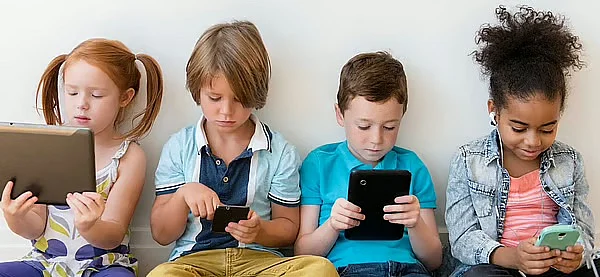UAE: Excessive Screen Time Leads To Rise In Myopia, Especially Among Students Under 10
Several doctors in the UAE are warning of a rise in myopia among schoolchildren, with excessive screen time emerging as a major driver of the condition. Younger children, especially those under 10, are proving most vulnerable as their visual systems are still developing.
Globally, the trend is no less concerning. About one in three children and teenagers is short-sighted, with the number projected to top 740 million worldwide by 2050, according to a pooled data analysis published in the British Journal of Ophthalmology.
A growing trend in UAE classrooms Recommended For YouDr Ahmed El-Barky, Consultant ophthalmology, Vitreoretinal surgeon & HOD Burjeel Hospital, Abu Dhabi, said,“There has been a measurable increase in myopia (nearsightedness) cases among school-age children in recent years. This trend is part of a global phenomenon often called the 'myopia boom,' but specific factors in the region, such as climate and lifestyle, have made it particularly pronounced.”
Stay up to date with the latest news. Follow KT on WhatsApp Channels.
He explained that while screens are not the sole cause, they act as a catalyst.“The relationship between screen time and myopia is complex, but research has provided strong evidence for a significant link. It's essential to recognize that screen time itself is not the direct cause of myopia, like a germ causes an infection. Instead, it acts as a major catalyst through several interconnected mechanisms.”
Risk multiplies with more hours on devices
Medics explained systematic reviews show that every extra hour of daily screen use is linked with significantly higher odds of developing myopia.
Dr Pavly Moawad, Specialist Ophthalmologist at Saudi German Hospital in Ajman, said,“Risk increases sharply with more hours spent on devices. During the pandemic, research also highlighted that greater screen time accelerated progression among adolescents.”
She added that children under ten face the highest risks.“Early onset before the age of seven or eight tends to result in more years of progression, raising the likelihood of more severe outcomes later in life. Outdoor time, on the other hand, is consistently shown to be protective.”
Outdoor play as a natural defenceDoctors emphasised that at least one to two hours outdoors daily can significantly lower both the risk of developing myopia and the speed of its progression. Treatments now range from specialised glasses and contact lenses such as orthokeratology to low-dose atropine drops.
To mitigate the risk, ophthalmologists in general recommend the 20-20-20 rule: for every 20 minutes of near work (including screens), look at something 20 feet away for at least 20 seconds.
Mowad added,“Parents can also help by ensuring good visual hygiene at home and school-maintaining proper lighting, encouraging correct posture, limiting glare, and managing screen distance. Building these habits alongside regular monitoring and specialist-guided treatments offers the best protection for children's eyesight in a digital age.”
Schools step inEducators in the UAE are also seeing the effects first-hand.“We are seeing more students requiring glasses or reporting vision difficulties,” said Dr Mirrah Agha Kandil, Group Medical Director, GEMS Education.“Alongside teachers referring students who struggle to see the board, we also proactively conduct screenings and, when needed, refer them to ophthalmologists.”
At GEMS schools, vision screenings are carried out at multiple stages - Grades 1, 4, 7, and 10 - as well as for all new students.“These screenings include assessments for myopia, colour vision deficits, and other visual concerns, with results shared with regulators. GEMS Education also engages parents and students in preventive health education to further promote long-term wellbeing,” she said.
Teachers on the frontlineOther school leaders also report an uptick in eye health concerns.
Lisa Johnson, Principal of American Academy for Girls, said,“Our teachers are attentive in the classroom and will flag if a student appears to be squinting, straining to see the board, or showing other signs of difficulty. It is also part of our screening if students are experiencing academic challenges. As part of our wellbeing program, we coach students to use apps or timers that help them self-monitor and limit screen time. I also use an app myself to track my screen time in order to maintain good health and a proper work-life balance.”
At Woodlem Park School in Hamidiya, Ajman, the approach is community-driven.
Principal Shiny Davison said,“We are taking proactive steps to protect eye health by closely working with parents. Teachers observe students for signs of strain - such as squinting or difficulty reading - and alert parents promptly. Most case identification is first seen by teachers. The school balances purposeful digital learning with outdoor activities, eye relaxation practices, and promotes the 20-20-20 rule. Regular eye check-ups and awareness sessions for students and parents form part of its wellness program.”

Legal Disclaimer:
MENAFN provides the
information “as is” without warranty of any kind. We do not accept
any responsibility or liability for the accuracy, content, images,
videos, licenses, completeness, legality, or reliability of the information
contained in this article. If you have any complaints or copyright
issues related to this article, kindly contact the provider above.
Most popular stories
Market Research

- R0AR Chain Launches Public Node Sale Following $1 Million Whitelist Success
- Forex Expo Dubai 2025 Returns October 67 With Exclusive Prize Draw Including Jetour X70 FL
- 1Inch Unlocks Access To Tokenized Rwas Via Swap API
- Falcon Finance Announced $FF And Community Sale On Buidlpad
- DOLLUM Expands Wallet Opportunities, Introducing New Security Features Following The DOL Token Sale
- Ethereum Based Meme Coin Pepeto Presale Past $6.6 Million As Exchange Demo Launches






















Comments
No comment